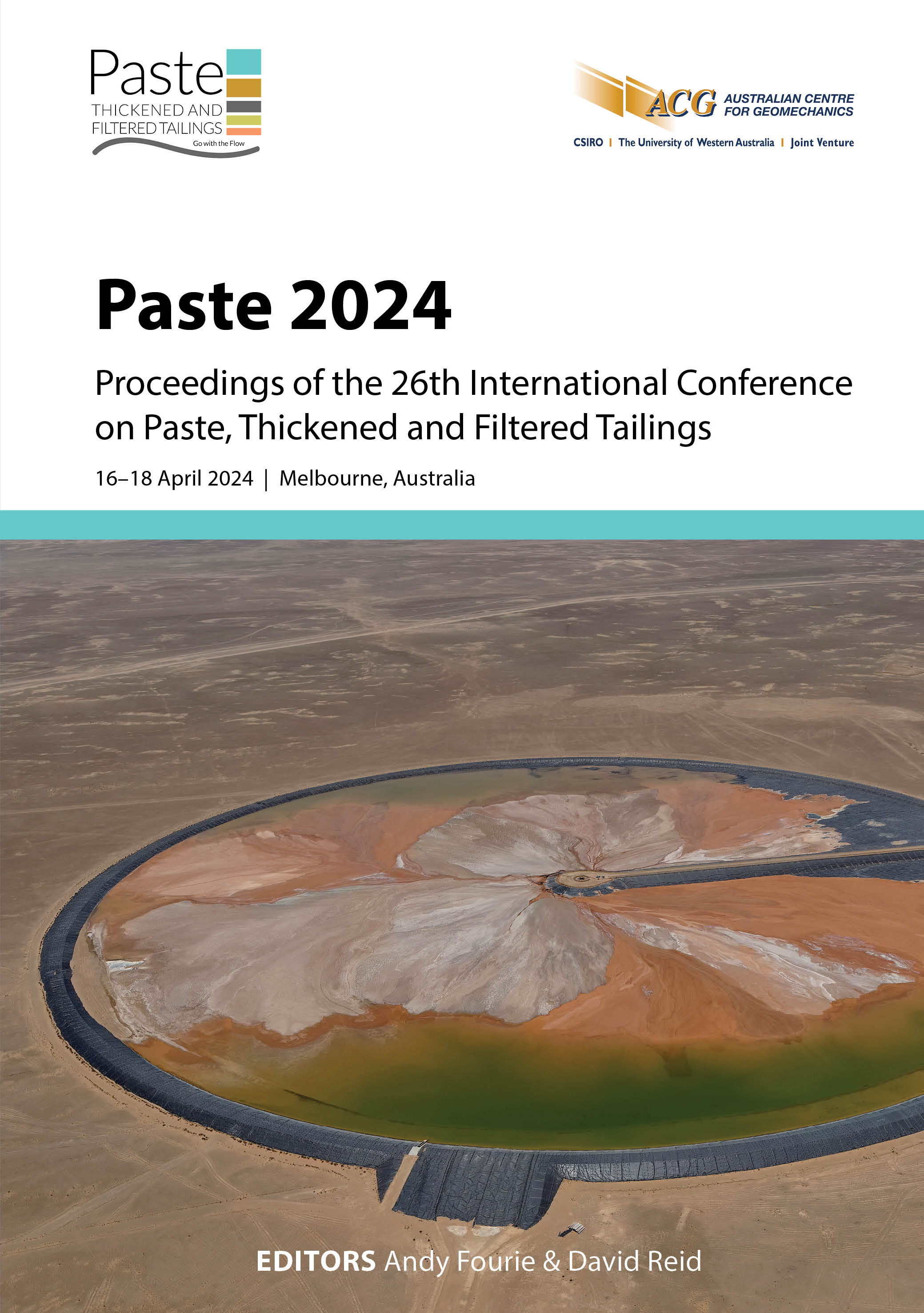An alternative approach to developing compaction specifications for tailings materials

|
Authors: Gerritsen, T; Wood, R; Llano-Serna, M; Meneses, B; Dressel, W |
DOI https://doi.org/10.36487/ACG_repo/2455_24
Cite As:
Gerritsen, T, Wood, R, Llano-Serna, M, Meneses, B & Dressel, W 2024, 'An alternative approach to developing compaction specifications for tailings materials', in AB Fourie & D Reid (eds), Paste 2024: Proceedings of the 26th International Conference on Paste, Thickened and Filtered Tailings, Australian Centre for Geomechanics, Perth, pp. 293-304, https://doi.org/10.36487/ACG_repo/2455_24
Abstract:
The adoption of the Global Industry Standard on Tailings Management requires that the most appropriate technology be adopted for the design, construction, and operation of a tailings storage facility (TSF). Dewatered tailings have been identified as the best technology for some sites. A structural zone is often considered when adopting a dewatered strategy. A structural zone can be built by placing/depositing tailings in controlled layers and compacting/trafficking the tailings as required. It is noted that the compaction specifications adopted today for tailings materials have mainly been based on those from the civil engineering industry. Often, the specifications for these materials are extensively expressed in ‘standard’ terms related to a laboratory compaction test method. Challenges arise because the laboratory compaction test was developed for different compactors from those used today. Consequently, such specifications may inadvertently lead to unmet engineering objectives and place unduly restrictive placement moisture content ranges on the tailings. The first part of the paper discusses the challenges of current compaction specifications. It highlights the benefits of defining a compaction specification using air content control and full compaction concepts, all in accordance with Proctor’s seminal work in the 1930s. The second part of this paper discusses some of the features of tailings compaction curves. The discussion includes the review of a database of compaction curves digitised during the literature review undertaken for the study. A general guideline to define a suitable specification for tailings compaction using the concepts defined in the study is proposed.
Keywords: tailings dams, compaction, dewatered tailings, dry stack, structural zone
References:
ASTM International 2021a, Standard Test Methods for Laboratory Compaction Characteristics of Soil Using Standard Effort (D 698).
ASTM International 2021b, Standard Test Methods for Laboratory Compaction Characteristics of Soil Using Modified Effort (D 1557).
Butikofer, D, Erickson, B, Marsh, A, Friedel, R, Murray, L & Piggott, MJ 2017, ‘Filtered tailings disposal case history: operations and design considerations part II’, Proceedings of the International Conference on Tailings and Mine Waste, University of Alberta Geotechnical Centre, Banff.
Goldup, N, Pyliuk, J, Zhang, G, Horne, B & Lepine, T 2019, ‘From design to operation: filtered tailings at the Meliadine Gold Mine, Nunavut’, Proceedings of the International Conference on Tailings and Mine Waste, University of British Columbia, Vancouver.
Jones, LD & Jefferson, J 2012, ‘Expansive soils’ in J Burland (ed.), ICE Manual of Geotechnical Engineering Volume 1: Geotechnical Engineering Principles. Problematic Soils and Site Investigation, Ice Publishing, London, pp.413–441.
Lambe, TW & Whitman, RV 1969, Soil Mechanics, volume 10, John Wiley & Sons, Hoboken.
Lara, JL & León, E 2011, ‘Design and operational experience of the Cerro Lindo filtered tailings deposit’, in R Jewell & AB Fourie (eds), Paste 2011: Proceedings of the 14th International Seminar on Paste and Thickened Tailings, Australian Centre for Geomechanics, Perth, pp. 25–37,
Money, B & Hodgson GJ 2016, Manual Of Contract Documents for Highway Works, Thomas Telford, London.
Pickens, GA 1980, ‘Alternative compaction specifications for non-uniform fill materials’, Australia-New Zealand Conference on Geomechanics, Institution of Professional Engineers New Zealand, Wellington.
Proctor, RR 1933, ‘Field and laboratory verification of soil suitability’, Engineering News-Record, vol. 111. no. 12, pp.348–351.
Tritico, PA & Langston, RE 1995, ‘Practice improvements for the design and construction of clay barriers’, Geoenvironment 2000: Characterization, Containment, Remediation, and Performance in Environmental Geotechnics, ASCE, Reston, pp. 624–640.
Yoder, EJ 1967, Principles of Pavement Design, John Wiley & Sons, Hoboken.
© Copyright 2026, Australian Centre for Geomechanics (ACG), The University of Western Australia. All rights reserved.
View copyright/legal information
Please direct any queries or error reports to repository-acg@uwa.edu.au
View copyright/legal information
Please direct any queries or error reports to repository-acg@uwa.edu.au
